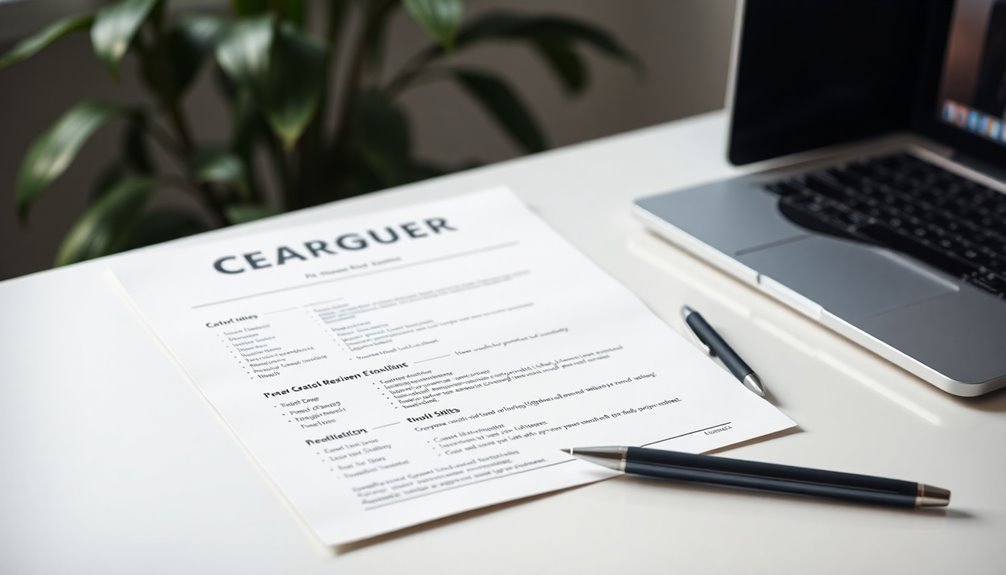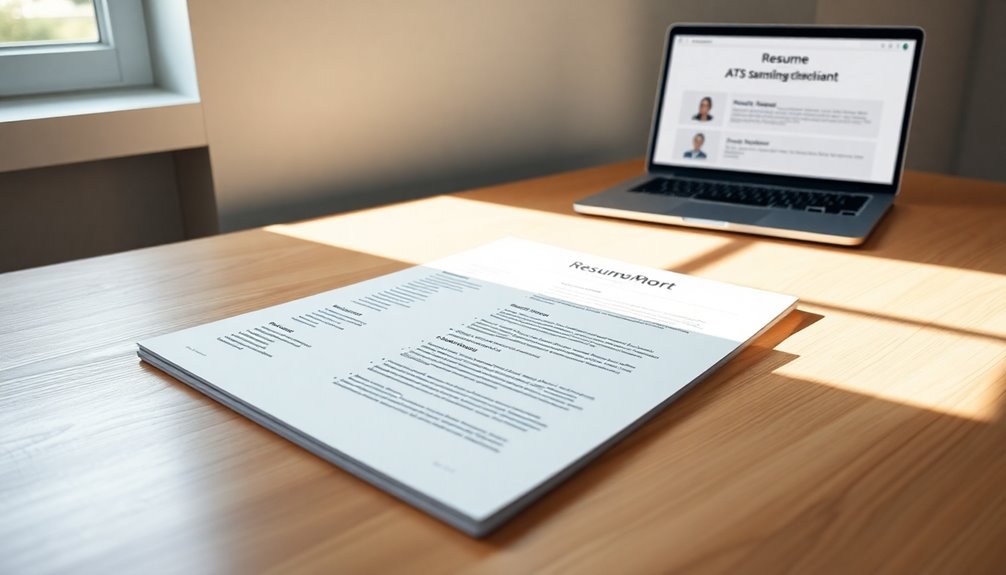The secret to impressing recruiters lies in a streamlined resume format. You've got to grab their attention fast since they spend only about seven seconds on each resume. Start with a clear professional summary and follow a reverse chronological order for your work experience. Use clean fonts like Arial or Calibri and avoid complex designs—keep it ATS-friendly! Incorporate relevant keywords from job descriptions to boost your chances against automated screening systems. Stick to one or two pages and guarantee consistency throughout. Ready to discover even more tips to elevate your resume game?
Key Takeaways
- Use a standard resume format with clear headings to enhance readability and ATS compatibility.
- Choose clean, legible fonts like Arial or Calibri for a professional appearance.
- Start with a strong professional summary that highlights key experiences relevant to the job.
- Present work experience in reverse chronological order, showcasing quantifiable achievements.
- Maintain consistent formatting throughout, ensuring uniformity in date formats and margins.
Importance of a Strong Resume

A strong resume is essential for making a lasting impression on potential employers. With recruiters spending an average of only 7 seconds reviewing each resume, your document needs to grab attention quickly. Over 75% of resumes get rejected without an interview; that's why crafting a standout resume is vital. A strong resume can boost your interview chances by up to 50%, enhancing your opportunity for job consideration.
Key elements that impress recruiters include clear contact information, a concise professional summary, and detailed work experience that highlights your achievements. Don't overlook the importance of a tailored skills section; this allows you to showcase the qualifications that align with the job description. Effective resume formatting also plays a significant role in hiring decisions. Busy recruiters prefer concise information that clearly showcases your qualifications and fits the role. Additionally, a well-structured resume can highlight your leadership skills and demonstrate your potential value to the organization.
Tailoring Your Resume Effectively

Tailoring your resume effectively can make all the difference in catching a recruiter's eye. Start by closely reviewing the job description and identifying relevant keywords. Since 90% of large companies use applicant tracking systems (ATS) to filter resumes, incorporating these keywords is essential.
Next, customize your professional summary to align with the position. Highlight your work experience by emphasizing key achievements that directly relate to the role. This not only enhances your resume's relevance but also demonstrates your suitability for the job.
Using industry-specific terminology can give you an edge, showcasing your familiarity with the field and improving your visibility to both ATS and recruiters. Remember, tailoring your resume isn't just a one-time task; it's beneficial to create multiple versions tailored to different roles. This allows you to emphasize relevant experiences and skills specific to each application.
Key Components to Highlight

Highlighting key components in your resume is vital for making a strong impression on potential employers. Start with a engaging professional summary that succinctly showcases your key experiences and measurable achievements tailored to the job title you're applying for.
Next, present your work experience in reverse chronological order, focusing on specific accomplishments rather than just listing responsibilities. Use quantifiable results to demonstrate your impact; this adds weight to your previous roles.
Don't forget your education! Clearly list your highest degree first, and include relevant coursework or honors to enhance your academic appeal. If you have any certifications relevant to the job, be sure to include them as well; they showcase your specialized skills and commitment to professional growth.
A well-structured skills section is important. Distinguish between hard skills, like project management, and soft skills, such as collaboration. Make sure these align with the job description for better visibility to recruiters. By emphasizing these key components, you'll create a powerful resume that stands out and increases your chances of landing that coveted interview.
Formatting for ATS Compatibility

When crafting your resume, making sure it's compatible with Applicant Tracking Systems (ATS) is essential for getting noticed by potential employers. To achieve ATS compatibility, stick to a standard resume format that includes conventional headings like "Work Experience" and "Education." This helps the system parse your information correctly.
Use a clean, legible font such as Arial, Calibri, or Times New Roman, maintaining one-inch margins for improved readability. Recruiters prefer resumes that are easy to read, and a clear format helps both ATS and hiring managers. Incorporate relevant industry keywords from the job description, as around 90% of large companies rely on these systems for initial candidate screening.
Consistent formatting is key; make sure you use correct date formats (MM/YYYY or fully spelled out) to enhance ATS extraction. Avoid using graphics, creative headings, or complex formats, as these can confuse applicant tracking systems and lead to important details being overlooked. By following these guidelines, you'll not only increase your chances of passing ATS filters but also make a positive impression on recruiters who value clarity and organization in your work experience. Additionally, highlighting your familiarity with testing tools can further demonstrate your relevant skills to potential employers.
Common Mistakes to Avoid

Even with a well-formatted resume, common mistakes can still jeopardize your chances of landing an interview. One major pitfall is neglecting to tailor your resume to specific job descriptions. Generic resumes often lead to rejection rates exceeding 50% due to irrelevant information. To stand out, incorporate keywords from the job posting that match your skills.
Another common mistake involves spelling and grammar errors. Over 70% of recruiters view these as dealbreakers, so double-check your work. Lengthy resumes, especially those over two pages, can deter recruiters; keep it concise and focused on key qualifications. Avoid including excessive information that distracts from your strongest points.
Furthermore, don't ignore the applicant tracking systems (ATS) that many companies use. Ascertain you use relevant keywords to prevent your resume from being filtered out. Finally, maintain consistent formatting throughout your document. Inconsistent font, margins, and styling can disrupt readability, making it harder for recruiters to find essential information quickly. By steering clear of these common mistakes, you'll enhance your chances of catching a recruiter's eye.
Frequently Asked Questions
What Resume Format Do Recruiters Generally Prefer?
Recruiters generally prefer a reverse chronological format for resumes. This layout clearly highlights your career progression and makes it easy for them to assess your work history at a glance. Use standard headings like "Work Experience," "Education," and "Skills" to enhance compatibility with applicant tracking systems. Keep your design clean with consistent fonts and sufficient white space, and opt for bullet points over lengthy paragraphs to present your qualifications concisely.
How Do I Get My Resume Noticed by Recruiters?
Getting your resume noticed by recruiters is like shining a spotlight in a dark room. First, tailor your resume to each job by including relevant keywords from the description. Use a clean, professional format that's easy to read. Highlight quantifiable achievements to showcase your impact. Keep it concise, ideally one page, and guarantee your contact information is up-to-date. With these steps, you'll improve your chances of standing out in a competitive job market.
How Many Seconds Does a Recruiter Look at Your Resume?
Recruiters typically spend only about 7 seconds reviewing your resume. This brief window means you've gotta make a strong first impression quickly. If your key qualifications and achievements aren't easily identifiable right away, you risk being overlooked. To grab their attention, focus on clarity and conciseness in your format. Use bullet points and strategic headings to guarantee they can skim through your essential details with ease and efficiency.
How to Make Your Resume Irresistible?
Is your resume a missed opportunity? To make it irresistible, start with a clean layout using standard fonts like Arial. Highlight key achievements in a tailored summary and use bullet points for clarity. Quantify your successes—like "increased sales by 25%"—to show real impact. Don't forget to sprinkle in relevant keywords for ATS optimization. Finally, keep it concise; a one-page resume can engage recruiters in just seconds.
Conclusion
In today's job market, a strong resume can make all the difference. Did you know that 75% of resumes never make it past the initial applicant tracking systems? By tailoring your resume, highlighting key components, and ensuring it's ATS-friendly, you'll greatly boost your chances of catching a recruiter's eye. Avoid common mistakes, and you'll be well on your way to landing that dream job. So, take the time to perfect your resume—it's worth it!
Felicity, our Author, pens in-depth articles and guides that delve into the heart of personal discovery. Her narrative-driven approach weaves together theory, practice, and personal anecdotes, making the journey of self-exploration both relatable and inspiring. Felicity’s contributions help illuminate the path for those seeking a deeper understanding of themselves and their relationships.










